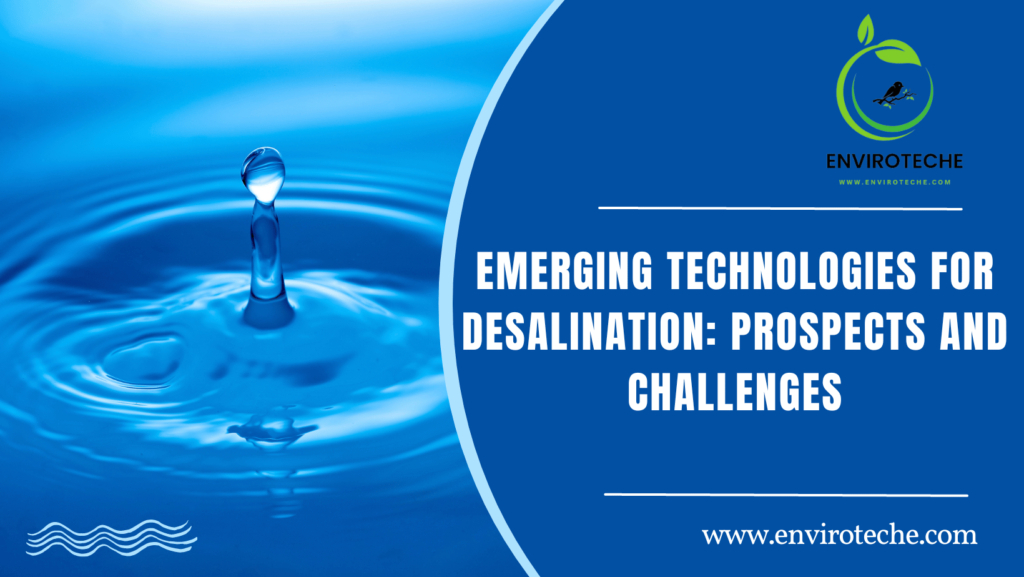
Aneeza Ishfaq1, Irfan Haidri1
1Department of Environmental Sciences, Government College University Faisalabad
Abstract
Water scarcity is a critical global concern impacting millions of individuals, particularly those residing in arid regions. As a means to combat this pressing challenge, desalination has emerged as a promising solution. Climate change is causing shifts in precipitation patterns, leading to more frequent droughts and water scarcity in many areas. Desalination provides a buffer against these climate impacts by utilizing seawater, an abundant resource that is not directly dependent on rainfall.
In this blog, we discussed about the concept of desalination, challenges, advanced solutions and potential to address the widespread water crisis faced by our planet.
Introduction
Desalination offers a viable solution to meet the increasing water demands of growing populations and expanding urban areas. As traditional freshwater sources become strained, DS provides an alternative source of clean, potable water (Angelakis et al., 2021). By tapping into abundant seawater or brackish water resources, DS plants can help bridge the gap between water supply and demand. Desalination allows for the diversification of water sources, reducing reliance on limited freshwater supplies like rivers, lakes, and underground aquifers.
This diversification enhances water security, especially in regions vulnerable to droughts or water scarcity. By incorporating desalinated water into the water supply mix, communities can mitigate the risks associated with relying solely on traditional sources (Ricart et al., 2020). As rising sea levels and changing weather patterns pose challenges to traditional water sources, desalination can help offset these effects and ensure a reliable supply of freshwater (Elmaadawy et al., 2020)..
Desalination Technologies
Reverse Osmosis (RO)
Reverse osmosis (RO) is one of the most widely used DS technologies. It involves the application of pressure to force water through a semi-permeable membrane, which allows water molecules to pass while removing salts, minerals, and other impurities. The membrane acts as a barrier, selectively allowing the passage of water molecules while blocking larger ions and particles (Skuse et al., 2021).
Advantages and Limitations of RO:
Reverse osmosis (RO) is a highly effective method for removing salts and impurities from water, producing high-quality drinking water. Compared to other DS methods, RO is relatively energy-efficient. It offers the advantage of modularity and scalability, allowing for flexible system design and capacity adjustments (Brogioli et al., 2018). RO systems are compatible with various water sources, including seawater and brackish water. Prior to entering the RO system, pre-treatment is required to remove suspended solids, organic matter, and specific contaminants (El Sayed et al., 2022).
Thermal Desalination:
Thermal DS involves the use of heat to evaporate water, separating it from salts and impurities, and then condensing the steam to produce freshwater. There are two main methods within thermal DS: multi-stage flash distillation (MSF) and multi-effect distillation (MED). Both methods rely on heat transfer and evaporation-condensation cycles to separate water from salts (Isah et al., 2022).
Advantages and Limitations of Thermal Desalination:
Thermal DS systems provide numerous advantages in treating high salinity water, including seawater. They exhibit the ability to handle feedwater with elevated concentrations of dissolved solids and contaminants. Furthermore, they demonstrate a lower susceptibility to membrane fouling in comparison to reverse osmosis (RO) systems. Certain thermal desalination systems can even capitalize on waste heat produced by industrial processes, resulting in enhanced energy efficiency (Brogioli et al., 2018).
Hybrid Technologies:
Hybrid desalination systems combine both RO and thermal DS processes to maximize efficiency and cost-effectiveness. In these systems, seawater is pre-treated using RO to remove a significant portion of salts and impurities. The partially desalinated water is then further treated using a thermal DS process to achieve freshwater production (Elmaadawy et al., 2020).
Improved Efficiency and Cost-Effectiveness:
Hybrid technologies leverage the strengths of both RO and thermal DS methods. By integrating these processes, they can reduce energy consumption, optimize freshwater production, and lower operational costs compared to standalone RO or thermal DS systems. Hybrid systems offer the potential for improved efficiency, especially when waste heat or renewable energy sources are utilized. Hybrid technologies continue to be an area of active research and development, aiming to enhance overall DS efficiency, reduce costs, and improve sustainability (Hsu et al., 2019).
By utilizing a combination of desalination technologies, communities can select the most suitable approach based on water source characteristics, energy availability, and cost considerations.
Environmental Considerations
A. Energy Requirements and Greenhouse Gas Emissions:
DS processes, particularly thermal desalination, have substantial energy requirements. The energy-intensive nature of desalination contributes to greenhouse gas emissions, primarily if fossil fuels are used for heat and electricity generation. However, advancements in energy recovery systems, utilization of renewable energy sources (such as solar or wind power), and improved process efficiencies aim to reduce the environmental footprint of desalination (Gude & Fthenakis, 2020).
Management of Brine Byproduct:
Desalination generates a concentrated brine byproduct that contains high levels of salts and other chemicals removed from the water. Proper management of the brine discharge is crucial to minimize its impact on the marine environment. Dilution with seawater, dispersion through diffusers, or evaporation ponds can be employed to reduce the brine’s salinity and discharge it in a controlled manner. Innovative solutions are being explored to extract valuable minerals and resources from brine, enhancing its overall sustainability (Shi et al., 2018).
Potential Impacts on Marine Ecosystems:
The discharge of brine into marine environments can have localized impacts on marine ecosystems, such as changes in salinity, temperature, and dissolved oxygen levels. These effects can disrupt marine life, including fish, corals, and other organisms. Careful site selection, proper monitoring, and adherence to environmental regulations are essential to minimize potential impacts on marine ecosystems. Research is ongoing to assess and mitigate any potential risks associated with brine discharge (Kress et al., 2020).
Overcoming Challenges and Future Prospects
Ongoing research focuses on improving the energy efficiency of desalination processes, including advancements in membrane technologies, optimization of thermal processes, and innovations in energy recovery systems. Additionally, exploring alternative and renewable energy sources such as solar, wind, or wave energy can significantly reduce the environmental impact of desalination (Okampo & Nwulu, 2021). Continued technological advancements aim to enhance the performance, reliability, and affordability of desalination systems. Research efforts focus on developing more efficient membranes, innovative pre-treatment methods, and advanced monitoring and control systems.
As technology improves and economies of scale are achieved, the cost of desalination is expected to decrease, making it more accessible for communities facing water scarcity (Roggenburg et al., 2021). Efforts are being made to increase the accessibility and implementation of desalination projects worldwide. This includes sharing knowledge, best practices, and capacity building initiatives to enable communities to develop and operate desalination facilities effectively. Collaboration between governments, NGOs, and private sectors plays a vital role in expanding access to desalination technologies and addressing water scarcity on a global scale (Debaere & Kapral, 2021).
Conclusion
Desalination holds significant potential as a solution to address global water scarcity. By meeting growing water demands, diversifying water sources, and mitigating the effects of climate change, desalination can play a crucial role in ensuring water security. However, it is important to prioritize sustainability and responsible water management practices throughout the entire desalination process, considering the energy requirements, brine byproduct management, and potential environmental impacts. With ongoing research, technological advancements, and increased accessibility, desalination has the potential to build a more resilient future where access to clean water is available to all.
References
Angelakis, A. N., Valipour, M., Choo, K.-H., Ahmed, A. T., Baba, A., Kumar, R., Toor, G. S., & Wang, Z. (2021). Desalination: From ancient to present and future. Water, 13(16), 2222.
Brogioli, D., La Mantia, F., & Yip, N. Y. (2018). Thermodynamic analysis and energy efficiency of thermal desalination processes. Desalination, 428, 29–39.
Debaere, P., & Kapral, A. (2021). The potential of the private sector in combating water scarcity: The economics. Water Security, 13, 100090.
El Sayed, M. M., Abulnour, A. M. G., Tewfik, S. R., Sorour, M. H., Hani, H. A., & Shaalan, H. F. (2022). Reverse osmosis membrane zero liquid discharge for agriculture drainage water desalination: Technical, economic, and environmental assessment. Membranes, 12(10), 923.
Elmaadawy, K., Kotb, K. M., Elkadeem, M. R., Sharshir, S. W., Dán, A., Moawad, A., & Liu, B. (2020). Optimal sizing and techno-enviro-economic feasibility assessment of large-scale reverse osmosis desalination powered with hybrid renewable energy sources. Energy Conversion and Management, 224, 113377.
Gude, V. G., & Fthenakis, V. (2020). Energy efficiency and renewable energy utilization in desalination systems. Progress in Energy, 2(2), 22003.
Hsu, C.-H., Ma, C., Bui, N., Song, Z., Wilson, A. D., Kostecki, R., Diederichsen, K. M., McCloskey, B. D., & Urban, J. J. (2019). Enhanced forward osmosis desalination with a hybrid ionic liquid/hydrogel thermoresponsive draw agent system. ACS Omega, 4(2), 4296–4303.
Isah, A. S., Takaijudin, H., & Singh, B. S. M. (2022). Principles and Modes of Distillation in Desalination Process. Distillation Processes: From Solar and Membrane Distillation to Reactive Distillation Modelling, Simulation and Optimization, 3.
Kress, N., Gertner, Y., & Shoham-Frider, E. (2020). Seawater quality at the brine discharge site from two mega size seawater reverse osmosis desalination plants in Israel (Eastern Mediterranean). Water Research, 171, 115402.
Okampo, E. J., & Nwulu, N. (2021). Optimisation of renewable energy powered reverse osmosis desalination systems: A state-of-the-art review. Renewable and Sustainable Energy Reviews, 140, 110712.
Ricart, S., Villar-Navascués, R., Gil-Guirado, S., Rico-Amorós, A. M., & Arahuetes, A. (2020). How to close the gap of desalinated seawater for agricultural irrigation? Confronting attitudes between managers and farmers in Alicante and Murcia (Spain). Water, 12(4), 1132.
Roggenburg, M., Warsinger, D. M., Evans, H. B., & Castillo, L. (2021). Combatting water scarcity and economic distress along the US-Mexico border using renewable powered desalination. Applied Energy, 291, 116765.
Shi, Y., Zhang, C., Li, R., Zhuo, S., Jin, Y., Shi, L., Hong, S., Chang, J., Ong, C., & Wang, P. (2018). Solar evaporator with controlled salt precipitation for zero liquid discharge desalination. Environmental Science & Technology, 52(20), 11822–11830.
Skuse, C., Gallego-Schmid, A., Azapagic, A., & Gorgojo, P. (2021). Can emerging membrane-based desalination technologies replace reverse osmosis? Desalination, 500, 114844.
Check Other Schlorships:


Good effort
Wonderful work!! Your contents are really interesting and important. Moreover, sentence fluency is very expressive and admirable.
Great effort !! Your contents are really interesting and important. Moreover, sentence fluency is very admirable….
You guys did great…A splendid job for sure.
A work of awareness that is needed to be flourished more.
Good luck.